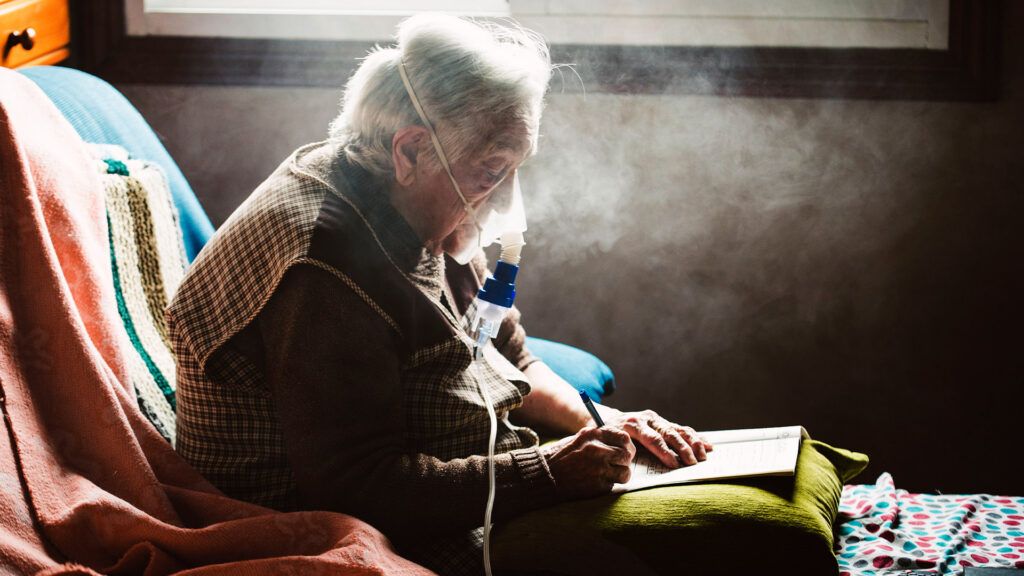People often use nebulizers to treat asthma, but they can also help treat a cough. If a cough is chronic or severe, a doctor may prescribe a nebulizer and certain medications.
A nebulizer is a device that turns liquid medication into a mist, allowing a person to inhale it. This method allows for the delivery of large doses of medication. People can use a nebulizer with a mouthpiece or mask, which they breathe through to take in the medication.
Nebulizers are ideal for people with difficulty using handheld inhalers, such as children.
Keep reading to learn more about how nebulizers can treat a cough, including how to use them, the medications they deliver, and what precautions to take.

When doctors prescribe nebulizers to treat a cough, the medications can provide relief in the following ways:
- breaking up mucus
- reducing inflammation
- reducing chest tightness or constriction
A person may use a nebulizer on a short-term basis, such as during a sudden worsening of cough symptoms or an asthma flare-up.
Another use of nebulizers is to help prevent the onset or worsening of symptoms. Generally, they work to regularly open the airways and reduce inflammation, making symptoms more manageable and flare-ups less likely.
Still, nebulizers do not treat the underlying cause of a cough, only the symptoms. They can provide short- and long-term relief but not a long-term cure.
Some common causes of a cough include:
- upper respiratory tract infections, such as the flu or a cold
- lower respiratory tract infections, such as bronchitis or pneumonia
- postnasal drip, a condition that leads to a buildup of mucus in the back of the throat
- inhaling irritants
- hay fever
- asthma
- smoking
Learn more about nebulizers and how they work.
Nebulizers generally deliver two types of medication: bronchodilators and corticosteroids.
Some examples include:
- Corticosteroids
- budesonide (Pulmicort)
- beclomethasone (Qvar)
- fluticasone
- Bronchodilators
- albuterol (Proventil HFA)
- levalbuterol (Xopenex HFA)
- terbutaline (Bronclyn)
This is not a comprehensive list. Other types and combinations exist.
People can also use nebulizers for other medications, such as cromolyn sodium (Intal nebulizer solution) and hypertonic saline.
The doctor or healthcare professional prescribing the nebulizer will explain how to use the nebulizer. Speak to them if there are any concerns or questions.
A nebulizer usually consists of five pieces, including a:
- medicine cup
- mask or mouthpiece
- cap, that attaches to the mask or mouthpiece
- thin plastic tube
- compressor machine
Steps include:
- Ensure hands are clean before touching any equipment.
- Add medication to the medicine cup, ensuring not to overfill the cup.
- Assemble the cup, cap, and mask together according to the instructions.
- The thin tube attaches on one end to the bottom of the cup and the other to the compressor machine.
- Turn the machine on.
- The nebulizer should start visibly producing mist from the mouthpiece or mask. If no mist is visible, the medicine cup or tubing might be loose. Wait a couple of minutes to see the mist.
- Once the nebulizer is working, a person puts the mouthpiece in their mouth or mask on their face and breathes. Take normal, regular breaths and use the machine until the medicine runs out.
- Wash mouth after use, especially when using corticosteroid medications.
As a person breathes, they gradually inhale the medication. The length of treatment differs between medications, ranging from 5–20 minutes.
Depending on the medication a person uses, they may use the nebulizer once or multiple times throughout the day.
Some precautions to take include:
- only filling the medicine cup with doctor-prescribed medications
- not breathing too heavily when using the nebulizer, as this can result in inhaling too much medication
- after using the nebulizer, ensure all equipment is cleaned using warm water and soap
- ensure medications for the nebulizer are stored appropriately, as per the instructions on the label
- ensure the compressor machine is working appropriately, and contact the equipment supplier if it is not
If a person is using the nebulizer regularly, they should also disinfect its parts once a week. Be careful not to let water into the thin plastic tube, though.
Sometimes, a doctor will prescribe nebulizers to children for cough symptoms. This can be because a child may experience difficulty taking the medications in other forms.
Still, some children may find it challenging to undergo the entire length of the treatment. In this case, a caregiver should try to comfort or distract the child.
Caregivers should never use or share nebulizer prescriptions to treat their children. A child should only use a nebulizer if a pediatrician prescribes it to them.
Cough symptoms are common, so it can be difficult for a person to know when to contact a doctor about them. Generally, a person should contact a doctor if:
- their cough lasts more than 3 weeks
- their cough is severe
- they cough up blood
- they experience wheezing, shortness of breath, chest pain, or fever, alongside their cough
Nebulizers can deliver various medications to help relieve cough symptoms. They are also uniquely easy to use, making them ideal for people who have difficulty with other medication delivery methods, such as young children and babies.
A doctor may prescribe them on a short- or long-term basis depending on a person’s symptoms and which medication they are using.
